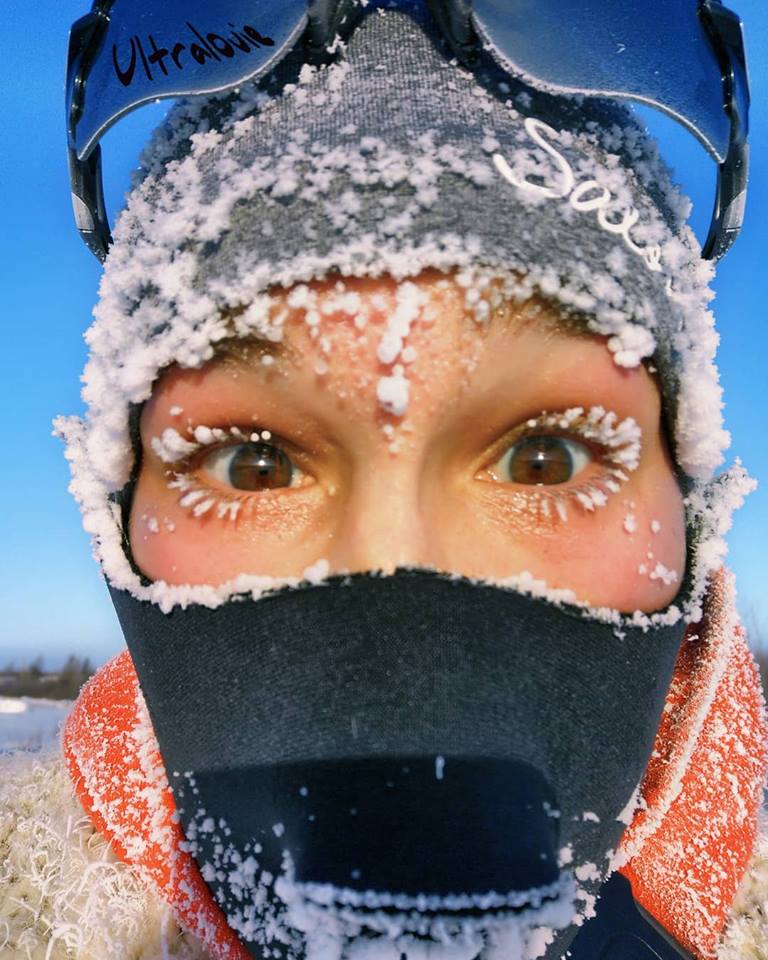| BY
ALIZA LAPIERRE for Runner's World
When I left the house,
the temperature was -20 degrees F., so I layered up clothing,
filled my flasks with hot water and made sure I had little
to no skin exposed. I had eaten a little extra knowing
that it takes calories to generate body heat and made
a thermos with tea to consume immediately after my run.
The previous weekend I had run 24 miles on the treadmill
due to inclement weather, so I really felt the need to
be outside running different surfaces and varied pitches.
The question that keeps coming to mind, though, is “How
cold is too cold?”
After doing some research there
seems to be no definite answer on what temperature should
deter you from running outside. What is clear is that
there are three main factors that should be taken into
consideration when determining what to wear and if running
outside is a good idea: air temperature, wind speed and
moisture. Taking into account these three factors, along
with your prescribed workout, you can determine that best
way to dress appropriately and decide if running outside
is worthwhile.
But how does the cold affect your
exercise? A study done by Myra Nimmo in the United Kingdom
examined how the body adapts to exercising in the cold
and found that your body burns more carbohydrates, less
fat and has a higher oxygen consumption at any intensity.
She also found that explosive power is limited by the
temperature of the muscles and in general, athletes are
vulnerable to performance deficits.
What kind of numbers are we talking?
Studies report that at a temperature of 0 degrees Fahrenheit,
there is an 8 to 9 percent decline in performance. Certainly
something under 10 percent doesn’t sound drastic,
but to put this into perspective, if at 50 degrees you
are running an 8-minute mile, then at 0 degrees your pace
would be 8:41. In other words, if you are running for
distance, your times may be considerably slower, while
your effort can be considerably higher.
Hydration is also affected. Cold
temperatures increase our respiratory fluid loss, our
sweat evaporates more quickly in cold air and our bodies’
thirst response is diminished. Even though we may not
feel the need to drink during a chilly run, it is important
even at those slower paces.
So is there a too cold? I think
each individual needs to determine this for himself or
herself based on experience, health, equipment and tolerance
to the elements. My simple advice is if you have a tempo
run or speed work on your schedule and it’s below
zero, then you should complete the workout inside to air
on the side of caution. On the other hand, if you are
simply logging miles and don’t mind braving the
elements then head outside.
In the cold, always layer up and
keep skin covered in order to protect yourself from frostbite
and if you are running on icy or slick conditions, put
some sheet metal screws in your shoes or wear a pair of
microspikes. Staying close to home doing smaller loops
provides you with the option to swap out bottles if yours
freeze and gives you a place to warm up quickly if needed.
If you are running in the cold and something feels amiss,
head inside and call it a day. Or finish your run on a
treadmill. Stay safe, and I will keep dreaming of warmer
temperatures and clear trails.
|










219.jpg)










